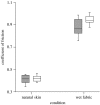Influence of epidermal hydration on the friction of human skin against textiles
- PMID: 18331977
- PMCID: PMC2607440
- DOI: 10.1098/rsif.2008.0034
Influence of epidermal hydration on the friction of human skin against textiles
Abstract
Friction and shear forces, as well as moisture between the human skin and textiles are critical factors in the formation of skin injuries such as blisters, abrasions and decubitus. This study investigated how epidermal hydration affects the friction between skin and textiles.The friction between the inner forearm and a hospital fabric was measured in the natural skin condition and in different hydration states using a force plate. Eleven males and eleven females rubbed their forearm against the textile on the force plate using defined normal loads and friction movements. Skin hydration and viscoelasticity were assessed by corneometry and the suction chamber method, respectively.In each individual, a highly positive linear correlation was found between skin moisture and friction coefficient (COF). No correlation was observed between moisture and elasticity, as well as between elasticity and friction. Skin viscoelasticity was comparable for women and men. The friction of female skin showed significantly higher moisture sensitivity. COFs increased typically by 43% (women) and 26% (men) when skin hydration varied between very dry and normally moist skin. The COFs between skin and completely wet fabric were more than twofold higher than the values for natural skin rubbed on a dry textile surface.Increasing skin hydration seems to cause gender-specific changes in the mechanical properties and/or surface topography of human skin, leading to skin softening and increased real contact area and adhesion.
Figures










References
-
- Adams M.J, Briscoe B.J, Johnson S.A. Friction and lubrication of human skin. Tribol. Lett. 2007;26:239–253. doi: 10.1007/s11249-007-9206-0. - DOI
-
- Agache P. Main skin biological and physical constants. In: Agache P, Humbert P, editors. Measuring the skin: non-invasive investigations, physiology, normal constants. Springer; Berlin, Germany: 2004. pp. 727–757.
-
- Agache P, Varchon D. Mechanical behavior assessment. In: Agache P, Humbert P, editors. Measuring the skin: non-invasive investigations, physiology, normal constants. Springer; Berlin, Germany: 2004. pp. 446–467.
-
- Bader D, Oomens C. Recent advances in pressure ulcer research. In: Romanelli M, Clark M, Cherry G, Colin D, Defloor T, editors. Science and practice of pressure ulcer management. Springer; London, UK: 2006. pp. 11–26.
Publication types
MeSH terms
LinkOut - more resources
Full Text Sources
Other Literature Sources
